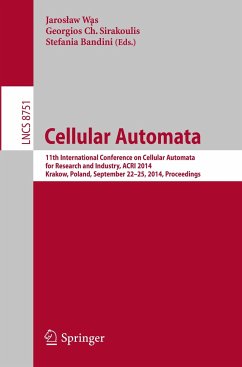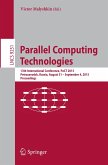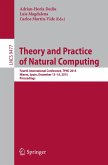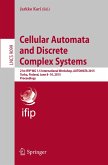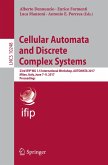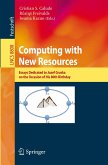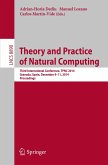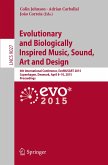Cellular Automata
11th International Conference on Cellular Automata for Research and Industry, ACRI 2014, Krakow, Poland, September 22-25, 2014, Proceedings
Herausgegeben:Was, Jaroslaw; Sirakoulis, Georgios Ch.; Bandini, Stefania
Cellular Automata
11th International Conference on Cellular Automata for Research and Industry, ACRI 2014, Krakow, Poland, September 22-25, 2014, Proceedings
Herausgegeben:Was, Jaroslaw; Sirakoulis, Georgios Ch.; Bandini, Stefania
- Broschiertes Buch
- Merkliste
- Auf die Merkliste
- Bewerten Bewerten
- Teilen
- Produkt teilen
- Produkterinnerung
- Produkterinnerung
This book constitutes the proceedings of the 11th International Conference on Cellular Automata for Research and Industry, ACRI 2014, held in Krakow, Poland, in September 2014. The 67 full papers and 7 short papers presented in this volume were carefully reviewed and selected from 125 submissions. They are organized in topical sections named: theoretical results on cellular automata; cellular automata dynamics and synchronization; modeling and simulation with cellular automata; cellular automata-based hardware and computing; cryptography, networks and pattern recognition with cellular…mehr
Andere Kunden interessierten sich auch für
![Parallel Computing Technologies Parallel Computing Technologies]() Parallel Computing Technologies38,99 €
Parallel Computing Technologies38,99 €![Theory and Practice of Natural Computing Theory and Practice of Natural Computing]() Theory and Practice of Natural Computing30,99 €
Theory and Practice of Natural Computing30,99 €![Cellular Automata and Discrete Complex Systems Cellular Automata and Discrete Complex Systems]() Cellular Automata and Discrete Complex Systems23,99 €
Cellular Automata and Discrete Complex Systems23,99 €![Cellular Automata and Discrete Complex Systems Cellular Automata and Discrete Complex Systems]() Cellular Automata and Discrete Complex Systems38,99 €
Cellular Automata and Discrete Complex Systems38,99 €![Computing with New Resources Computing with New Resources]() Computing with New Resources38,99 €
Computing with New Resources38,99 €![Theory and Practice of Natural Computing Theory and Practice of Natural Computing]() Theory and Practice of Natural Computing36,99 €
Theory and Practice of Natural Computing36,99 €![Evolutionary and Biologically Inspired Music, Sound, Art and Design Evolutionary and Biologically Inspired Music, Sound, Art and Design]() Evolutionary and Biologically Inspired Music, Sound, Art and Design36,99 €
Evolutionary and Biologically Inspired Music, Sound, Art and Design36,99 €-
-
-
This book constitutes the proceedings of the 11th International Conference on Cellular Automata for Research and Industry, ACRI 2014, held in Krakow, Poland, in September 2014. The 67 full papers and 7 short papers presented in this volume were carefully reviewed and selected from 125 submissions. They are organized in topical sections named: theoretical results on cellular automata; cellular automata dynamics and synchronization; modeling and simulation with cellular automata; cellular automata-based hardware and computing; cryptography, networks and pattern recognition with cellular automata. The volume also contains contributions from ACRI 2014 workshops on crowds and cellular automata; asynchronous cellular automata; traffic and cellular automata; and agent-based simulation and cellular automata.
Produktdetails
- Produktdetails
- Theoretical Computer Science and General Issues 8751
- Verlag: Springer / Springer International Publishing / Springer, Berlin
- Artikelnr. des Verlages: 86381666, 978-3-319-11519-1
- 2014
- Seitenzahl: 732
- Erscheinungstermin: 5. September 2014
- Englisch
- Abmessung: 235mm x 155mm x 40mm
- Gewicht: 1095g
- ISBN-13: 9783319115191
- ISBN-10: 3319115197
- Artikelnr.: 41346052
- Herstellerkennzeichnung Die Herstellerinformationen sind derzeit nicht verfügbar.
- Theoretical Computer Science and General Issues 8751
- Verlag: Springer / Springer International Publishing / Springer, Berlin
- Artikelnr. des Verlages: 86381666, 978-3-319-11519-1
- 2014
- Seitenzahl: 732
- Erscheinungstermin: 5. September 2014
- Englisch
- Abmessung: 235mm x 155mm x 40mm
- Gewicht: 1095g
- ISBN-13: 9783319115191
- ISBN-10: 3319115197
- Artikelnr.: 41346052
- Herstellerkennzeichnung Die Herstellerinformationen sind derzeit nicht verfügbar.
Conductivity, Memristivity and Creativity in Cellular Automata.- Automata Formalism.- Towards a Comprehensive Understanding of Multi-state CellularAutomata.- Iterative Arrays with Set Storage.- Isotropic Cellular Automaton for Excitable Media with Random Neighbor Selection.- Power Spectral Analysis of the Computation Process by Rule 110.- Cellular Automata and Formulae on Monoids.- A Scalable Method for Constructing Non-linear Cellular Automata with Period 2n - 1.- Systolic Dissemination in the Arrowhead Family.- Cellular Automata Dynamics and SynchronizationOn the Dynamics of Multi-information in Cellular Automata.- Lyapunov Exponents of One-Dimensional, Binary Stochastic Cellular Automata.- Synthesis of Non-uniform Cellular Automata Having only Point Attractors.- Non Uniform Cellular Automata Description of Signed Partition Versions of Ice and Sand Pile Models.- Variable Entangling in a Quantum Battle of the Sexes Cellular Automaton.- Experimental Finitization of Infinite Field-Based Generalized FSSP Solution.- Cellular Automata (CA) Model for Primality Test.- Numerical Modelling of Fracture Based on Coupled Cellular AutomataFinite Element Approach.- Two-Layer CA Model for Simulating Catalytic Reaction at Dynamically Varying Temperature.- Modelling Ordered Nanopourous Structures by Anodization via Cellular Automata.- Overview of Cellular Automaton Models for Corrosion.- Cellular Automata Finite Element Approach for Modelling Microstructure Evolution under Thermo-Mechanical Processing Conditions.- A Preliminary Cellular Model for Secondary Lahars and Simulation of 2005 Case of Vascun Valley, Ecuador.- Vulnerability and Protector Control: Cellular Automata Approach.- UNDATA: A Preliminary Cellular Automata Model for Tsunami Simulation.- Modeling Rainfall Features Dynamics in a DEM Satellite Image withCellular Automata.- Cellular Automata Model with Game Theory for Power Management of Hybrid Renewable Energy Smart Grids.- A Novel Algorithm for Coarse-Grainingof Cellular Automata.- Cellular Automata Model for Protein Structure Synthesis (PSS).- The Basic Reproduction Number for Chagas Disease Transmission Using Cellular Automata.- Modelling Spatial Distribution of the Barents Sea Cod Fishery.- Training Cellular Automata to Simulate Urban Dynamics: A Computational Study Based on GPGPU and Swarm Intelligence.- Cellular Automaton Approach to Arching in Two-Dimensional Granular Media.- Modeling of Friction Dynamic Motion by Cellular Automata.- Agent Based Simulation of Spreading in Social-Systems of Temporarily Active Actors.- Cellular Automata for Modeling Language Change.- Sznajd Model with Memory.- Detecting Emergent Phenomena in Cellular Automata Using Temporal Description Logics.- Cellular Automata-Based Hardware and Computing Direction-Reversible Self-Timed Cellular Automata for Delay-Insensitive Circuits.- Implementation of a Cellular Automaton with Globally Switchable Rules.- Highly Compact Automated Implementation of Linear CA on FPGAs.- Shortest Path Computing Using Memristor-Based Circuits and Cellular Automata.- Cryptography, Networks and Pattern Classification with Cellular Automata Generation of TPMACA for Pattern Classification.- Sharing Secrets by Computing Preimages of Bipermutive Cellular Automata.- Inapplicability of Fault Attacks against Trivium on a Cellular Automata Based Stream Cipher.- Cellular Automata Approach to Maximum Lifetime Coverage Problem in Wireless Sensor Networks.- C and CA - Int. Workshop on Crowds and Cellular AutomataApplication of NIST Technical Note 1822 to CA Crowd Dynamics Models Verification and Validation.- Effect of Group Behavior on Crowd Dynamics.- Effects of Boundary Conditions on Single-File Pedestrian Flow.- Simulation Study of the Spiral Motion of Pedestrians: A Cellular Automata Approach.- CA Crowd Modeling for a Retirement House Evacuation with Guidance.- Multiscale Simulation of Pedestrians for Faster Than Real Time Modeling in Large Events.- Cellular Automata Pedestrian Movement Model SIgMA.CA:Model Parameters as an Instrument to Regulate Movement Regimes.- Case Study of Phase Transition in Cellular Models of Pedestrian Flow.- Simulation of Public Opinion with Ideas of Cellular Automata.- Estimating Speeds of Pedestrians in Real-World Using Computer Vision.- Geometric Characterization of Hereditarily Bijective Boolean Networks.- Inner-Independent Radius-Dependent Totalistic Rule of Universal Asynchronous Cellular Automaton.- Bifurcations of Local Structure Maps as Predictors of Phase Transitions in Asynchronous Cellular Automata.- Computing Symbolic Steady States of Boolean Networks.- Equivalences in Multi-valued Asynchronous Models of Regulatory Networks.- Effective Parallelism Rate by Reversible PCA Dynamics.- Quick Convergence to a Fixed Point: A Note on Asynchronous Elementary Cellular Automata.- A Study of Aggregated Speed in Road Networks Using Cellular Automata.- A New Cellular Automaton Model with Spatiotemporal Process of Lane Changing Execution.- Cellular Automaton Model with Non-hypothetical Congested Steady State Reproducing the Three-Phase Traffic Flow Theory.- Asymmetric Lane Change Rules for a Microscopic Highway TrafficModel.- Interactions between Multiple Junctions.- Modeling Disruption and Recovery of Traffic in Road Networks.- Simulation of Pedestrians Behavior in a Shopping Mall.- How Agents Can Form a Specific Pattern.- An Integrated Model for the Simulation of Pedestrian Crossings.- Agent-Based Pedestrian Activity Simulation in Shopping Environments Using a Choice Network Approach.- Software Implementation of Population of Cognitive Agents Learning to Cross a Highway.- The Effects of Supraregional Innovation and Production Collaboration on Technology Development in a Multiregional World: A Spatial Agent-Based Model Study.
Conductivity, Memristivity and Creativity in Cellular Automata.- Automata Formalism.- Towards a Comprehensive Understanding of Multi-state CellularAutomata.- Iterative Arrays with Set Storage.- Isotropic Cellular Automaton for Excitable Media with Random Neighbor Selection.- Power Spectral Analysis of the Computation Process by Rule 110.- Cellular Automata and Formulae on Monoids.- A Scalable Method for Constructing Non-linear Cellular Automata with Period 2n - 1.- Systolic Dissemination in the Arrowhead Family.- Cellular Automata Dynamics and SynchronizationOn the Dynamics of Multi-information in Cellular Automata.- Lyapunov Exponents of One-Dimensional, Binary Stochastic Cellular Automata.- Synthesis of Non-uniform Cellular Automata Having only Point Attractors.- Non Uniform Cellular Automata Description of Signed Partition Versions of Ice and Sand Pile Models.- Variable Entangling in a Quantum Battle of the Sexes Cellular Automaton.- Experimental Finitization of Infinite Field-Based Generalized FSSP Solution.- Cellular Automata (CA) Model for Primality Test.- Numerical Modelling of Fracture Based on Coupled Cellular AutomataFinite Element Approach.- Two-Layer CA Model for Simulating Catalytic Reaction at Dynamically Varying Temperature.- Modelling Ordered Nanopourous Structures by Anodization via Cellular Automata.- Overview of Cellular Automaton Models for Corrosion.- Cellular Automata Finite Element Approach for Modelling Microstructure Evolution under Thermo-Mechanical Processing Conditions.- A Preliminary Cellular Model for Secondary Lahars and Simulation of 2005 Case of Vascun Valley, Ecuador.- Vulnerability and Protector Control: Cellular Automata Approach.- UNDATA: A Preliminary Cellular Automata Model for Tsunami Simulation.- Modeling Rainfall Features Dynamics in a DEM Satellite Image withCellular Automata.- Cellular Automata Model with Game Theory for Power Management of Hybrid Renewable Energy Smart Grids.- A Novel Algorithm for Coarse-Grainingof Cellular Automata.- Cellular Automata Model for Protein Structure Synthesis (PSS).- The Basic Reproduction Number for Chagas Disease Transmission Using Cellular Automata.- Modelling Spatial Distribution of the Barents Sea Cod Fishery.- Training Cellular Automata to Simulate Urban Dynamics: A Computational Study Based on GPGPU and Swarm Intelligence.- Cellular Automaton Approach to Arching in Two-Dimensional Granular Media.- Modeling of Friction Dynamic Motion by Cellular Automata.- Agent Based Simulation of Spreading in Social-Systems of Temporarily Active Actors.- Cellular Automata for Modeling Language Change.- Sznajd Model with Memory.- Detecting Emergent Phenomena in Cellular Automata Using Temporal Description Logics.- Cellular Automata-Based Hardware and Computing Direction-Reversible Self-Timed Cellular Automata for Delay-Insensitive Circuits.- Implementation of a Cellular Automaton with Globally Switchable Rules.- Highly Compact Automated Implementation of Linear CA on FPGAs.- Shortest Path Computing Using Memristor-Based Circuits and Cellular Automata.- Cryptography, Networks and Pattern Classification with Cellular Automata Generation of TPMACA for Pattern Classification.- Sharing Secrets by Computing Preimages of Bipermutive Cellular Automata.- Inapplicability of Fault Attacks against Trivium on a Cellular Automata Based Stream Cipher.- Cellular Automata Approach to Maximum Lifetime Coverage Problem in Wireless Sensor Networks.- C and CA - Int. Workshop on Crowds and Cellular AutomataApplication of NIST Technical Note 1822 to CA Crowd Dynamics Models Verification and Validation.- Effect of Group Behavior on Crowd Dynamics.- Effects of Boundary Conditions on Single-File Pedestrian Flow.- Simulation Study of the Spiral Motion of Pedestrians: A Cellular Automata Approach.- CA Crowd Modeling for a Retirement House Evacuation with Guidance.- Multiscale Simulation of Pedestrians for Faster Than Real Time Modeling in Large Events.- Cellular Automata Pedestrian Movement Model SIgMA.CA:Model Parameters as an Instrument to Regulate Movement Regimes.- Case Study of Phase Transition in Cellular Models of Pedestrian Flow.- Simulation of Public Opinion with Ideas of Cellular Automata.- Estimating Speeds of Pedestrians in Real-World Using Computer Vision.- Geometric Characterization of Hereditarily Bijective Boolean Networks.- Inner-Independent Radius-Dependent Totalistic Rule of Universal Asynchronous Cellular Automaton.- Bifurcations of Local Structure Maps as Predictors of Phase Transitions in Asynchronous Cellular Automata.- Computing Symbolic Steady States of Boolean Networks.- Equivalences in Multi-valued Asynchronous Models of Regulatory Networks.- Effective Parallelism Rate by Reversible PCA Dynamics.- Quick Convergence to a Fixed Point: A Note on Asynchronous Elementary Cellular Automata.- A Study of Aggregated Speed in Road Networks Using Cellular Automata.- A New Cellular Automaton Model with Spatiotemporal Process of Lane Changing Execution.- Cellular Automaton Model with Non-hypothetical Congested Steady State Reproducing the Three-Phase Traffic Flow Theory.- Asymmetric Lane Change Rules for a Microscopic Highway TrafficModel.- Interactions between Multiple Junctions.- Modeling Disruption and Recovery of Traffic in Road Networks.- Simulation of Pedestrians Behavior in a Shopping Mall.- How Agents Can Form a Specific Pattern.- An Integrated Model for the Simulation of Pedestrian Crossings.- Agent-Based Pedestrian Activity Simulation in Shopping Environments Using a Choice Network Approach.- Software Implementation of Population of Cognitive Agents Learning to Cross a Highway.- The Effects of Supraregional Innovation and Production Collaboration on Technology Development in a Multiregional World: A Spatial Agent-Based Model Study.

